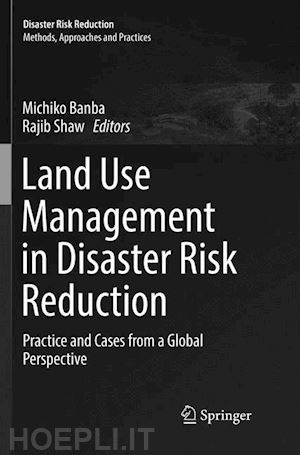
Questo prodotto usufruisce delle SPEDIZIONI GRATIS
selezionando l'opzione Corriere Veloce in fase di ordine.
Pagabile anche con Carta della cultura giovani e del merito, 18App Bonus Cultura e Carta del Docente
This book provides a wide range of studies on methods of assessing natural disaster risks and reducing those risks in the context of land use. A major benefit of the book is that it presents extensive research and practices from interdisciplinary perspectives through case studies of land use management against various natural disasters. The natural hazards include earthquakes, tsunami, floods, and other disasters, with case studies ranging from urban areas to areas with natural environments such as mountains, coasts, and river systems. By quantitative and qualitative analysis, this work illustrates how interactions between natural and human environments create natural disasters, and how disaster risks can be managed or reduced through methods related to land use.
This book also covers a variety of challenges in land use management with sample cases from Asia as well as the United States and Europe. The main purpose is to provide greater insight into studies of natural disaster risks from the perspective of land use and the possibility of non-engineering methods to reduce those risks. This goal can be achieved through management of land use against various natural hazards in diverse environments.
Michiko Banba is an associate professor at the Education and Research Center for Disaster Reduction of the University of Hyogo, Japan. Her research field is land use, land management, and urban and regional management in the context of disaster risk reduction. Her research field is mainly in Asian counties including Japan, Indonesia, and Nepal. She works closely with local governments and communities to plan and develop policies and countermeasures to reduce disaster risks and to build the capacity of communities against disaster.
Rajib Shaw was a professor in the Graduate School of Global Environmental Studies of Kyoto University, Japan. He worked closely with local communities, NGOs, governments, and international organizations, including the United Nations, especially in Asian countries. He is currently the co-chair of the United Nations Asia Science Technology Academia Advisory Group (ASTAAG) and the president of the Asian University Network of Environment and Disaster Management (AUEDM). His research interests are community-based disaster risk management, climate-change adaptation, urban risk management, and disaster and environmental education. He has published several books in the field of disaster and environmental management and is also the chief editor of the Asian Journal of Environment and Disaster Management.











Il sito utilizza cookie ed altri strumenti di tracciamento che raccolgono informazioni dal dispositivo dell’utente. Oltre ai cookie tecnici ed analitici aggregati, strettamente necessari per il funzionamento di questo sito web, previo consenso dell’utente possono essere installati cookie di profilazione e marketing e cookie dei social media. Cliccando su “Accetto tutti i cookie” saranno attivate tutte le categorie di cookie. Per accettare solo deterninate categorie di cookie, cliccare invece su “Impostazioni cookie”. Chiudendo il banner o continuando a navigare saranno installati solo cookie tecnici. Per maggiori dettagli, consultare la Cookie Policy.